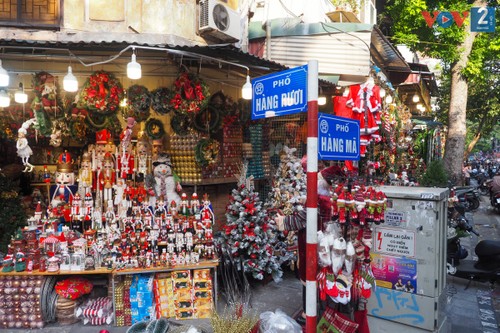 Hang Ma street in Hanoi’s Old Quarter sells various kinds of Christmas goods. Hang Ma street in Hanoi’s Old Quarter sells various kinds of Christmas goods. |
A: The Christmas spirit is definitely alive in Hang Ma street in Hanoi’s Old Quarter, where many shops are already selling Christmas goods. Hang Ma street is known for selling decorations for every occasion: birthdays, weddings, the Mid-Autumn Festival, Halloween, Christmas, and both New Years.
B: Here at VOV, we’ve been receiving Christmas greetings from our listeners. Thanks you all for your greetings and we wish you a Merry Christmas and Happy New Year.
B: Listener Kinoshita Hiromichi of Fukuoka, Japan, asks: “When does winter begin in Vietnam? What are the iconic winter flowers? Does Vietnam have special flower farms for export?”
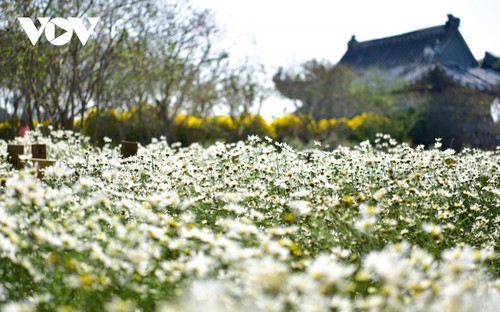 Daisies in full boom in November and early December Daisies in full boom in November and early December |
A: December officially marks the arrival of winter in Vietnam. Winter mainly affects the northern mountain provinces of Ha Giang, Lao Cai, and Son La, which will see some cold, gloomy weather next month. The temperatures can drop below 0 degrees Celsius at the height of winter, bringing snowy, icy weather.
B: In the early winter, the temperatures in Hanoi hover around 25 degrees Celsius. While it’s drier now than in other seasons, there may still be occasional drizzles.
A: Meanwhile, in the central region, Danang and Hoi An are experiencing cool, rainy weather. Ho Chi Minh City and the Mekong Delta enjoy warm weather all year round.
B: Due to topographical and climate differences, different localities in Vietnam have different flowers. Hanoi is now in the season of daisies, which bloom during a 3-week period in early winter. In the past, daisies were wildflowers, but now many flower farms grow daisies on a large scale. It’s trendy now to display daisies in your home and take photos with daisies in a garden or beside a flower cart.
A: Daisies are grown on farms all around the capital. Tay Tuu, Quang An, and Nhat Tan flower villages are famous for immense white fields of daisies in full bloom.
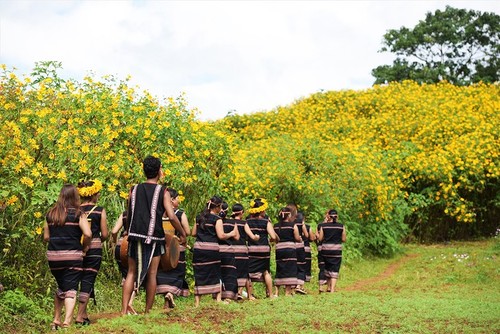 Wild sunflowers season in Gia Lai province (photo: baoquangnam.vn) Wild sunflowers season in Gia Lai province (photo: baoquangnam.vn) |
B: In late November and early December, wild sunflowers bloom in some localities. Chu Dang Ya, an inactive volcano, is a paradise of wild sunflowers, which makes it one of top 10 attractions in Gia Lai province this time of year. From the top of the mountain visitors have a panoramic view of green forests and yellow fields of sunflowers growing out of red basalt soil.
A: At this time of the year every hillside and stream in Gia Lai is the color of wild yellow sunflowers. For people in the Central Highlands, the sunflowers signal the arrival of winter.
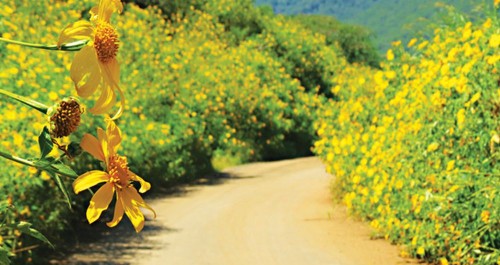 Wild sunflowers stretch both sides of the 4-km road on Ba Vi mountain. (photo: dulichbavi.com) Wild sunflowers stretch both sides of the 4-km road on Ba Vi mountain. (photo: dulichbavi.com) |
B: People in Hanoi go to nearby Ba Vi to see wild sunflowers. Ba Vi is a hilly district west of Hanoi where, in the 1920s, the French built private villas and a church, and planted sunflowers.
A: Seeing the popularity of these flowers, over the past few years, Ba Vi National Park has planted even more wild sunflowers along forest paths to attract more visitors.
B: Now wild sunflowers bloom along the 4km road from the foot of the mountain right up to the entrance of the park, their yellow color stretching along both sides of the road.
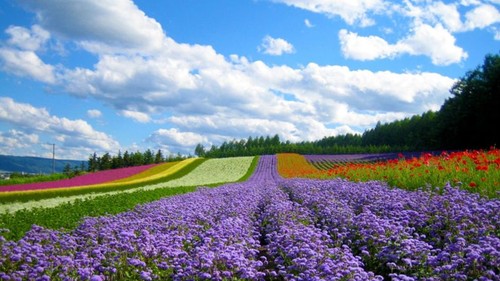 A flower farm in Da Lat (photo: tapchixaydung.vn) A flower farm in Da Lat (photo: tapchixaydung.vn) |
A: Listener Kinoshita Hiromichi of Fukuoka, Japan, also asked about Vietnam’s flower exports. Da Lat city in the Central Highlands province of Lam Dong is Vietnam’s flower hub, supplying flowers nationwide and exporting them abroad. Its goal is to raise its annual flower export value far beyond the current 50 million US dollars. Da Lat is already producing 3.1 billion flower stems each year.
B: Da Lat is in the Langbiang Highlands, about 1,500m above sea level. Growing flowers became a local occupation in 1938 when migrants from Hanoi’s traditional flower villages of Ngoc Ha and Nghi Tam moved to the area. Soon flower villages like Ha Dong, Thai Phien, and Van Thanh began popping up all around Da Lat.
A: A wide variety of flowers beautify Da Lat – roses, lavender, tulips, bigleaf hydrangea, carnations, gladioluses, violets, daisies, Texas bluebells, and wild Himalayan cherry.
B: The city’s appearance changes depending on the time of the year. You’ll see the radiant red of wild Himalayan cherry blooms in January, purple Texas bluebells in April, and yellow mimosa in October.
A: Da Lat currently has around 9,000 hectares of flowers, annually producing over 3.1 billion stems of flowers, only 10% of which are exported. Every year, Da Lat imports 50-90 million plants, stems, seeds, bulbs, and tubers of new flower varieties for assay and production. The city leaders hope that by 2030, at least 30% of local flower and vegetable varieties will meet the requirements for export, and 90% of local vegetable and flower producers will be using hi-tech farming methods.
B: Next, check out some more letters and reception reports from listeners. Yasu N, a Japanese listener, told us he’s interested in Vietnamese President Vo Van Thuong’s official visit to Japan. He says is currently following information from Vietnamese media and would appreciate it if we could report in detail on Mr. Thuong’s meetings with the Emperor and Empress, Prime Minister Kishida, and others.
A: Please stay tuned to VOV or visit our website at vovworld.vn for reports on President Thuong’s official trip to Japan which is also spotlighted in Japanese media including the Japanese government’s website, Japan Times, Public broadcaster NHK and the Tokyo Broadcasting System (TBS), and many others as well.
B: Waveney Bowman commented on our Sunday show titled “Schubert in a Mug: Intimate classical music concerts for all”: “I love what you are doing, Phuc and Hsin-Chiao, and wish I could be there in person to hear you play once again. I have so many wonderful memories of our time together.”
A: Your friends are doing very well in Vietnam. We hope you can meet them again in Vietnam one day.
B: Christer Brunström of Sweden said: “I enjoyed your broadcast in English on December 26th. I tuned in on shortwave at 11885 kHz.
A: Thank you for dropping us a note, Christer, to let us know you’re still with us regularly.
B: M. S. Sreenivasa Raju of India listened to VOV’s English program via shortwave on a Sony ICF SW 35 radio with a 15-meter antenna on the frequency of 7220 kHz. He rated SINPO 34443, with good to fair audio quality.
A: Ding Lu of China received the English program at 16:00 UTC on the frequencies 7220kHz, 9730kHz, and 11885kHz. All these frequencies had a very strong signal, he said, and the reception was very clear.
B: Thank you all for sending us your feedback. We welcome your letters at English Service, VOVWorld, the Voice of Vietnam, 45 Ba Trieu street, Hanoi, Vietnam. Or you can email us at englishsection@vov.vn. You’re invited to visit us online at vovworld.vn, where you can hear both live and recorded programs. Once again, thank you all for listening. Goodbye!